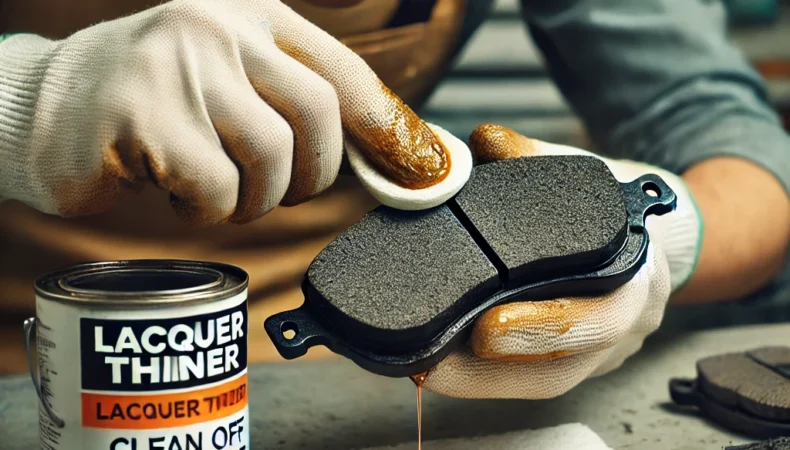Introduction
Brake pads are a crucial component of any vehicle’s braking system, providing the friction needed to stop your vehicle safely. However, if oil contaminates the brake pads, it can severely diminish their effectiveness, leading to dangerous driving conditions. Cleaning oil off brake pads can restore their performance, and lacquer thinner is one of the solvents that can be used for this task. In this guide, we’ll walk you through the steps to safely and effectively clean oil off brake pads using lacquer thinner.
Why It’s Important to Clean Oil Off Brake Pads
Oil on brake pads can reduce friction, leading to longer stopping distances and potential brake failure. It can also cause the pads to glaze over, reducing their ability to grip the brake rotors. Cleaning the brake pads promptly ensures your braking system remains effective and your vehicle safe to drive.
Tools and Materials You’ll Need
Before you start, gather the following tools and materials:
- Lacquer thinner
- A clean, lint-free cloth or rag
- Safety gloves
- Safety glasses
- A well-ventilated workspace
- A container to catch excess lacquer thinner
- A wire brush (optional, for tougher grime)
Safety Precautions
Lacquer thinner is a strong solvent that can be hazardous if not handled properly. Follow these safety tips:
- Work in a Well-Ventilated Area: Lacquer thinner emits strong fumes that can be harmful if inhaled in large quantities. Always work in a well-ventilated area, preferably outdoors or in a garage with open doors.
- Wear Protective Gear: Wear safety gloves and glasses to protect your skin and eyes from splashes. Lacquer thinner can cause skin irritation and eye damage.
- Keep Away from Heat Sources: Lacquer thinner is highly flammable. Ensure there are no open flames, sparks, or heat sources nearby while you work.
Step-by-Step Guide to Cleaning Oil Off Brake Pads with Lacquer Thinner
1. Remove the Brake Pads
- Step 1: Begin by safely lifting your vehicle using a jack and securing it with jack stands. Ensure the vehicle is stable before you start working.
- Step 2: Remove the wheel to access the brake caliper. Use a wrench or socket set to remove the caliper bolts and carefully slide the caliper off the rotor.
- Step 3: Take out the brake pads from the caliper. Be mindful of their orientation so you can reinstall them correctly.
2. Inspect the Brake Pads
- Step 1: Inspect the brake pads for wear and damage. If they are too thin or severely damaged, it might be safer to replace them rather than attempting to clean them.
- Step 2: Check the surface of the brake pads. If they are heavily contaminated with oil, you’ll need to clean them thoroughly.
3. Apply Lacquer Thinner
- Step 1: Pour a small amount of lacquer thinner into a clean container. Dip a lint-free cloth or rag into the lacquer thinner, allowing it to soak up the solvent.
- Step 2: Gently scrub the surface of the brake pads with the cloth, applying light pressure. Ensure the entire surface is cleaned, paying attention to areas with visible oil stains.
- Step 3: If the oil is stubborn, you can use a wire brush dipped in lacquer thinner to gently scrub the surface. Be careful not to damage the pad material.
4. Wipe and Dry the Brake Pads
- Step 1: After scrubbing, use a clean, dry cloth to wipe off the excess lacquer thinner and any remaining oil residue from the brake pads.
- Step 2: Allow the brake pads to air dry completely. Lacquer thinner evaporates quickly, but it’s crucial that the pads are fully dry before reinstallation.
5. Reinstall the Brake Pads
- Step 1: Once the brake pads are clean and dry, reinstall them into the caliper, ensuring they are correctly positioned.
- Step 2: Reattach the caliper to the rotor and tighten the bolts securely. Make sure everything is properly aligned.
- Step 3: Reinstall the wheel and lower the vehicle back to the ground.
Troubleshooting Tips
- Persistent Oil Stains: If the oil stains are not coming off with lacquer thinner, it might be an indication that the pads are too contaminated to be cleaned effectively. In such cases, replacing the brake pads is recommended.
- Brake Squeal After Cleaning: If you notice any unusual noises after cleaning and reinstalling the brake pads, check to ensure that all components are properly aligned and that no residual lacquer thinner is left on the pads or rotor.
Conclusion
Cleaning oil off brake pads using lacquer thinner can be an effective solution to restore their functionality. By following these steps, you can safely remove oil contaminants and ensure that your brake pads perform as expected. Always remember to work in a well-ventilated area and wear protective gear when handling lacquer thinner. Regular maintenance and prompt cleaning of your brake pads can help you avoid more significant brake issues down the road.
Faq
Oil on brake pads can drastically reduce their effectiveness, leading to longer stopping distances and potential brake failure. Cleaning oil off the pads ensures that your vehicle’s braking system remains safe and functional.
While various solvents can remove oil, lacquer thinner is effective due to its strong degreasing properties. However, it’s important to handle lacquer thinner with care as it’s highly flammable and can be harmful if not used properly.
Always work in a well-ventilated area to avoid inhaling fumes, wear safety gloves and glasses to protect your skin and eyes, and keep lacquer thinner away from open flames or heat sources as it is highly flammable.
If the brake pads are heavily saturated with oil or if the oil stains persist after cleaning with lacquer thinner, it’s safer to replace the pads. Cleaning may not restore their full effectiveness, and using compromised pads can be dangerous.
Dip a lint-free cloth into the lacquer thinner and gently scrub the brake pads. For stubborn stains, you can use a wire brush dipped in lacquer thinner. Always wipe the pads with a clean, dry cloth afterward and allow them to air dry completely.
No, you should allow the brake pads to dry completely before reinstalling them. Lacquer thinner evaporates quickly, but any remaining solvent could affect braking performance if not fully dried.
If you experience brake squeal after cleaning, check to ensure that the pads and caliper are properly aligned and that no residual lacquer thinner is left on the pads or rotor. Squealing can also indicate worn pads or other brake system issues.
It’s recommended to remove the brake pads from the vehicle before cleaning to ensure thorough removal of oil and to avoid contaminating other parts of the brake system with lacquer thinner.
Brake pads should only need cleaning if they become contaminated with oil or another substance. Regular inspections of your brake system will help you catch any issues early, but routine cleaning isn’t typically necessary unless contamination occurs.
If lacquer thinner spills on other parts of your vehicle, immediately wipe it off with a clean cloth. Be particularly careful around painted surfaces, as lacquer thinner can strip paint.
Last modified: August 13, 2024




